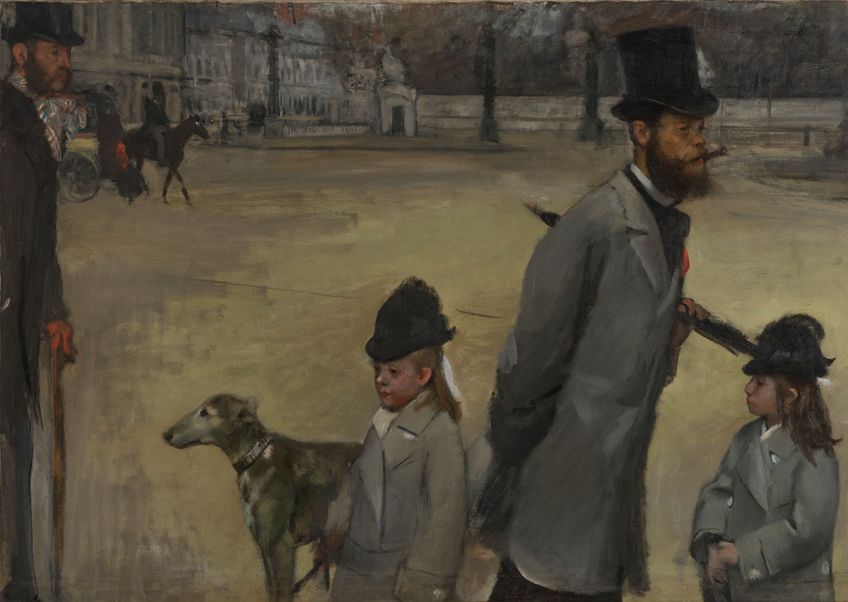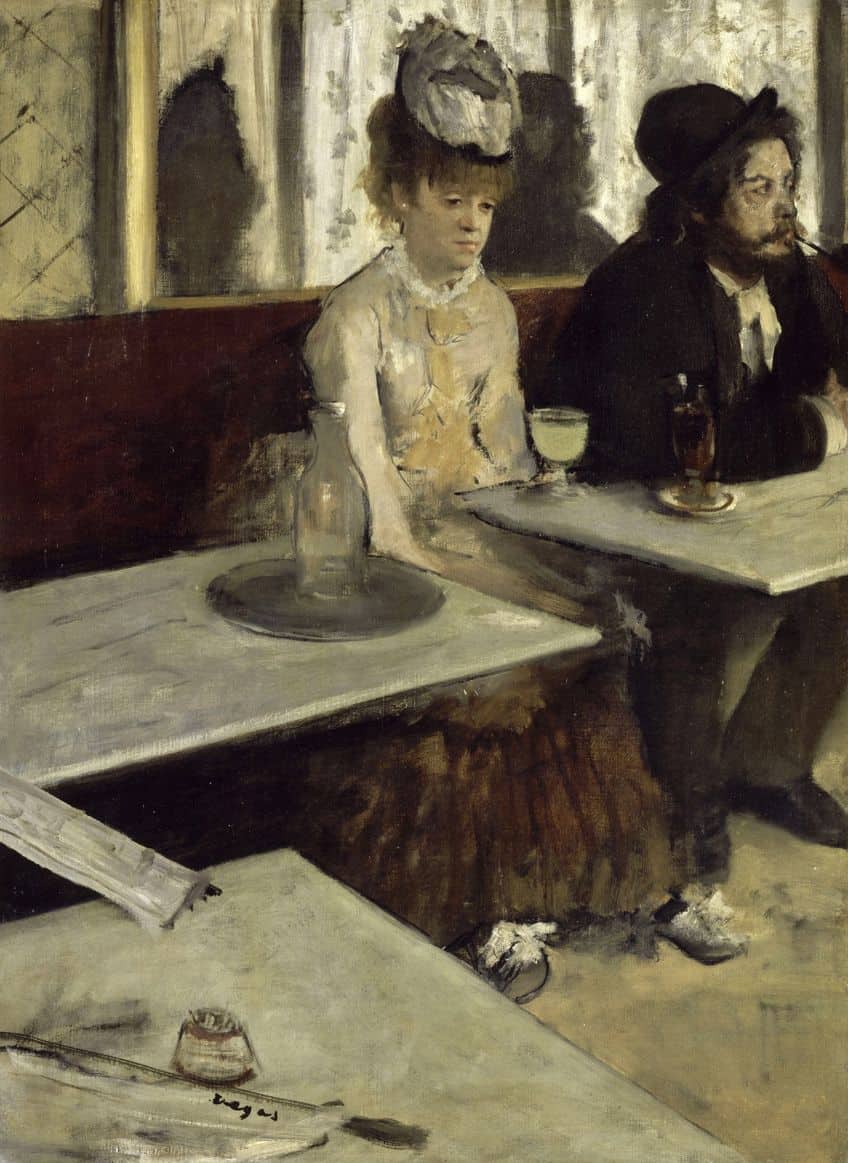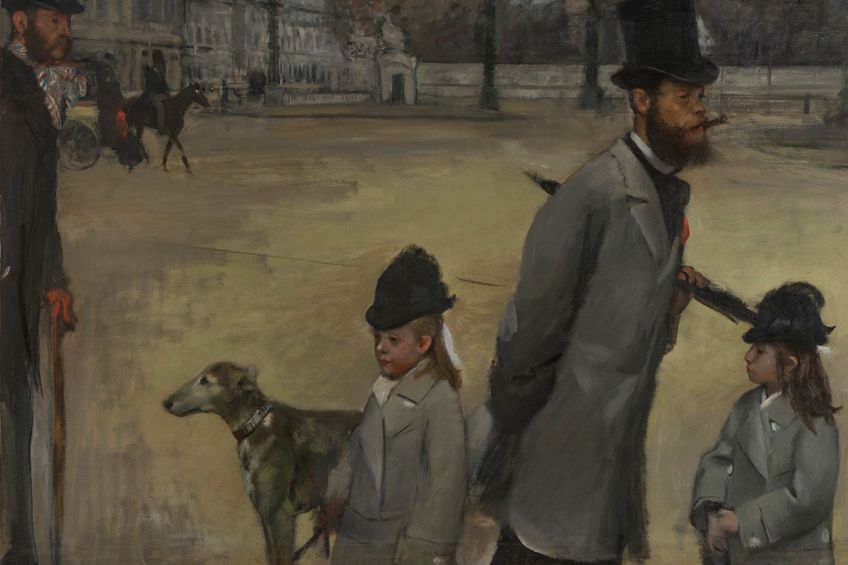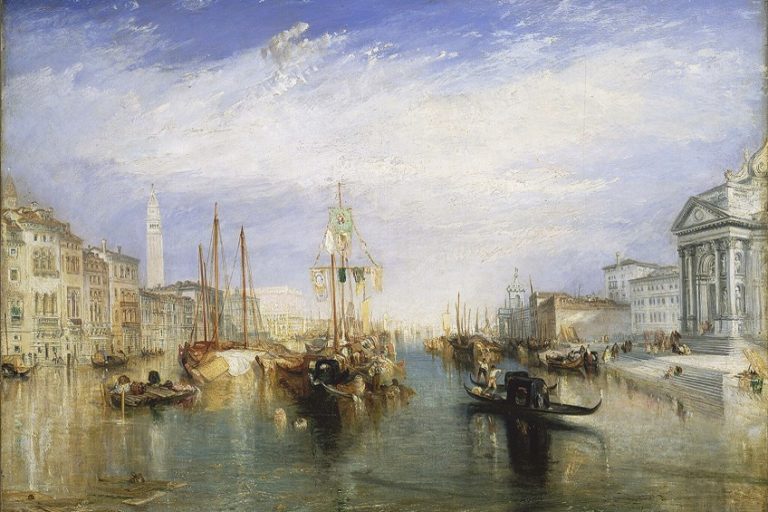“Place de la Concorde” by Edgar Degas – An Artwork Analysis
Place de la Concorde by Edgar Degas is a remarkable example of the artist’s innovative approach to composition and urban life. Painted in 1875, this oil on canvas captures a fleeting moment in one of Paris’s most famous squares. The painting features Ludovic Lepic, a friend of Degas, and his daughters strolling across the plaza, with the distant architectural landmarks providing a backdrop. Notable for its unconventional cropping and dynamic arrangement, the artwork reflects Degas’s fascination with movement and modernity, challenging traditional perspectives and offering a unique snapshot of 19th-century Parisian life.
Key Takeaways
- Degas’s Place de la Concorde was painted in 1875 and captures a moment in a famous Parisian square.
- The scene highlights both the interconnectedness and isolation of urban life through meticulous composition.
- Detailed depictions of the figures and background showcase Degas’s observational prowess and unique approach.
Historical Context
| Artist | Edgar Degas (1834 – 1917) |
| Date Created | 1875 |
| Medium | Oil on canvas |
| Genre | Impressionism |
| Period/Movement | Impressionism |
| Dimensions (cm) | 78.4 x 117.5 |
| Series/Versions | None |
| Where Is It Housed? | Hermitage Museum, Saint Petersburg, Russia |
| What It Is Worth | Estimated between $15- and 20 million (value based on recent market trends) |
Edgar Degas’s painting, Place de la Concorde, captures a striking moment in 1875 Paris, illustrating Ludovic-Napoléon Lepic and his daughters as they cross the iconic square. The scene is notable for its casual depiction of everyday life, a departure from traditional commissioned works. The Tuileries Gardens can be seen in the background, adding to the painting’s authentic Parisian atmosphere.

The painting reveals Degas’s keen observational skills, capturing both the bustle and solitude of urban life. The figures are meticulously spaced, suggesting an almost fragmented world where the connections between people are subtle yet profound. This composition is unique among Degas’s works, showing an innovative approach to portraying public spaces. Degas’s use of light and shadow enhances the realism of the scene, while the informal poses of Lepic and his daughters add a personal touch. The background, with its detailed representation of the Tuileries Gardens, further grounds the painting in its specific historical and geographical context.
The artwork stands as a testament to Degas’s ability to blend everyday moments with deeper social commentary.
Impressionism and Degas
Edgar Degas was a key figure in the Impressionist movement, which began in France in the late 19th century. Unlike many of his contemporaries, Degas focused more on urban life. His works often depicted scenes from the city and the people within it. Place de la Concorde showcases his interest in daily life and social dynamics. Impressionism aimed to capture moments in time with quick brush strokes and an emphasis on light and color. Degas, however, uniquely combined these techniques with careful composition and attention to form. He drew inspiration from Japanese prints and Parisian photography, integrating these influences into his paintings. This blend is visible in the structured yet spontaneous feel of Place de la Concorde.

Paris in the 19th Century
The 19th century was a period of transformation for Paris. After the Franco-Prussian War (1870 – 1871), the city underwent significant political and social changes. Paris’s reconstruction included broad boulevards and open spaces designed by Baron Haussmann, making it a vibrant and modern metropolis. Place de la Concorde is set against this backdrop of change. It depicts a bustling urban scene with Viscount Ludovic Lepic and his daughters crossing the square. The painting subtly hints at the tensions and changes of the time, especially with elements like the hidden Strasbourg statue, which reflects France’s recent territorial losses.
Paris’s modernization and the complexities of its society are integral to understanding Degas’s work. The city’s evolving landscape and its impact on daily life are captured in his paintings, providing a snapshot of history and culture during this pivotal era.
Analysis of Place de la Concorde
Place de la Concorde by Edgar Degas is notable for its artistic composition, subject matter, use of color, and unique portrayal of modern life. Each of these elements contributes to the painting’s depth and meaning.

Artistic Composition
Degas skillfully arranges the elements within the painting to create a balanced, yet dynamic composition. The figures, including Viscount Lepic and his two daughters, are positioned to lead the viewer’s eye across the canvas. The combination of diagonals and vertical lines adds movement and tension. The off-center placement of the figures adds an element of spontaneity.
The background features the Tuileries Gardens, creating a layered depth that enhances the composition.

Subject Matter and Color
The painting depicts Ludovic-Napoléon Lepic, his daughters Eylau and Jeanine, his dog, and a solitary man. The use of color is restrained, with earthy tones and muted shades creating a realistic atmosphere. The subtle use of color captures the light and shadows of the Place de la Concorde, emphasizing the time of day and weather conditions.
This adds to the overall mood and realism of the scene.

Use of Negative Space
Degas uses negative space effectively to highlight the isolation and separation within the bustling setting. The expansive area of Place de la Concorde stretches out, creating a sense of emptiness around the figures. This use of negative space contrasts with the busy nature of the scene, emphasizing the characters’ solitude.
The careful balance between filled and empty spaces helps convey the themes of connection and isolation.

Depiction of Modern Life
Degas captures a snapshot of modern life in 19th-century Paris, with elements like the carriage, fashionable clothing, and casual postures of the figures. The painting reflects urban life and the social dynamics of the time. The characters appear to be immersed in their own worlds, adding to the painting’s narrative complexity.
This realistic portrayal of everyday moments is a hallmark of Degas’s work, illustrating the intersection of public and private life in a modern city.

Artistic Techniques and Legacy
Edgar Degas skillfully used a range of artistic techniques that set his work apart and significantly impacted future generations of artists. His painting, Place de la Concorde, showcases these innovative methods and left a lasting legacy on modern art.

Degas’ Unique Techniques
Degas was known for his keen eye for observation and his ability to capture fleeting moments. In Place de la Concorde, he utilized cropping, a technique inspired by photography. The painting’s composition, with its abrupt cut-offs, reflects the influence of photographic framing. He also employed loose brushwork to create a sense of movement and spontaneity. This can be seen in the detailed depiction of the carriages and the figures crossing the Parisian square. His use of light and shadow added depth, enhancing the realism of the scene.
Another key feature in this painting is the sense of isolation among the figures. Despite being in a busy square, the subjects, such as the cigar-smoking Lepic and his daughters, appear detached from one another. This reflects Degas’ interest in the fragmented nature of modern life.
Influence on Modern Art
Degas’ approach had a profound influence on modern art, particularly in the realm of French impressionism. His innovative compositions and techniques were admired by his contemporaries, including Gustave Caillebotte. The use of cropping and unconventional perspectives in Place de la Concorde broke traditional norms and paved the way for future artists to experiment with new visual narratives. His ability to capture the essence of Parisians and daily life also inspired later works focusing on urban scenes and the complexities of modern existence. Degas’ legacy can also be seen in how he inspired future generations to explore themes of isolation and disconnection in their work. Paintings like L’absinthe reflect these themes, showing individuals caught in moments of personal withdrawal amid public spaces. Overall, Degas’ techniques and explorations left a lasting mark on the trajectory of modern art.

Provenance and Historical Significance
Place de la Concorde by Edgar Degas has a rich history, reflecting its journey through various owners and the impact of significant events, such as World War II. This section explores these themes in detail. Place de la Concorde has had several notable owners throughout its history. Initially painted in 1875, it showcased the Viscount Lepic, a prominent flâneur, along with his daughters, Eylau and Jeanine Lepic, in the iconic Place de la Concorde in Paris. In the early 20th century, the painting became part of the extensive collection of Otto Gerstenberg, a renowned German industrialist and art collector. Gerstenberg’s impressive collection included numerous works of art, with Place de la Concorde being a standout piece.
Today, this remarkable oil painting is housed in the Hermitage Museum in Saint Petersburg, Russia. It is prominently displayed, drawing attention from art enthusiasts from around the world who come to admire Degas’ masterful depiction of urban life.
Impact of World War II
World War II left an indelible mark on the art world, and Place de la Concorde was no exception. During the war, many artworks were displaced, stolen, or hidden to protect them from looting and destruction. Place de la Concorde was one of the artworks moved for safekeeping. The war’s chaotic environment posed significant risks to treasured pieces like Degas’ painting, prompting art collectors and curators to take protective measures. Despite the turmoil, the painting survived and continues to be an important piece in the art historical canon. Its journey during the war reflects the broader challenges faced by cultural artifacts during times of conflict, underscoring the resilience of art through turbulent periods.

Place de la Concorde stands as a testament to the Degas’ mastery of capturing everyday moments with a sense of vibrancy and modernity. Through his innovative composition and keen observation of urban life, Degas invites viewers into the bustling world of 19th-century Paris, where moments of leisure and urban spectacle intertwine. This artwork not only showcases Degas’s technical skill but also highlights his ability to infuse ordinary scenes with a sense of timelessness, making Place de la Concorde a timeless piece that continues to captivate audiences with its dynamic energy and rich historical context.
Frequently Asked Questions
What Are the Defining Features of Place de la Concorde by Degas?
Place de la Concorde, also known as Viscount Lepic and his Daughters Crossing the Place de la Concorde, was painted in 1875. It includes Ludovic-Napoléon Lepic, his daughters, a dog, and a solitary man. The Tuileries Gardens can be seen in the background.
How Does Place de la Concorde Represent Degas’ Style Within the Impressionist Movement?
Degas is known for his keen observation and use of unusual compositions. In Place de la Concorde, he captures a fleeting moment, typical of the Impressionist focus on modern life. The off-center placement of figures and the informal posture highlight his distinctive style.
What Historical Events Are Depicted or Reflected in Degas’ Place de la Concorde?
The painting does not directly depict historical events but reflects the Parisian lifestyle in the late 19th century. The use of Place de la Concorde as the setting connects to its historical significance, as it was the site of many important events in French history.
How Has Degas’ Place de la Concorde Influenced Modern Perceptions of the Artist?
Place de la Concorde showcases Degas’ ability to blend everyday scenes with complex compositions. It has reinforced his reputation as a master observer and innovator within the Impressionist movement. The painting continues to be studied for its technical prowess and social commentary.
Isabella studied at the University of Cape Town in South Africa and graduated with a Bachelor of Arts majoring in English Literature & Language and Psychology. Throughout her undergraduate years, she took Art History as an additional subject and absolutely loved it. Building on from her art history knowledge that began in high school, art has always been a particular area of fascination for her. From learning about artworks previously unknown to her, or sharpening her existing understanding of specific works, the ability to continue learning within this interesting sphere excites her greatly.
Her focal points of interest in art history encompass profiling specific artists and art movements, as it is these areas where she is able to really dig deep into the rich narrative of the art world. Additionally, she particularly enjoys exploring the different artistic styles of the 20th century, as well as the important impact that female artists have had on the development of art history.
Learn more about Isabella Meyer and the Art in Context Team.
Cite this Article
Isabella, Meyer, ““Place de la Concorde” by Edgar Degas – An Artwork Analysis.” Art in Context. June 12, 2024. URL: https://artincontext.org/place-de-la-concorde-by-edgar-degas/
Meyer, I. (2024, 12 June). “Place de la Concorde” by Edgar Degas – An Artwork Analysis. Art in Context. https://artincontext.org/place-de-la-concorde-by-edgar-degas/
Meyer, Isabella. ““Place de la Concorde” by Edgar Degas – An Artwork Analysis.” Art in Context, June 12, 2024. https://artincontext.org/place-de-la-concorde-by-edgar-degas/.











